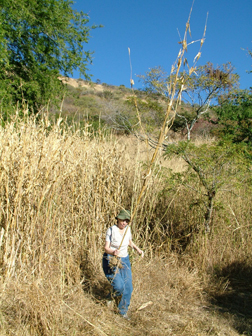|
Web Extra Monday, July 2, 2007
Climate kick-started agriculture
 Courtesy of Matthew Lachniet |
| Dolores Piperno, seen here in a teosinte patch in Mexico's Balsas Valley, and colleagues examined soils in the region to determine when agriculture began there. |
It has long been thought that agriculture got its beginnings
when humans had to adjust to a change in climate in ancient Mesopotamia. Now,
new research using microfossil plant data in southern Mexico is potentially
linking the beginning of agriculture in the New World with a change in climate
as well.
At the end of the Pleistocene period and beginning of the Holocene period, between
13,000 and 10,000 years ago, temperatures and precipitation substantially increased
in the Balsas Valley region of southern Mexico, Dolores Piperno of the Smithsonian
National Museum of Natural History and the Smithsonian Tropical Research Institute
in Panama and colleagues wrote May 30 in the Proceedings of the National
Academy of Sciences. During this timeframe, the climate switched from dry
and cool to a more seasonal climate like that of today with wet and dry seasons,
says Matthew Lachniet, a geologist at the University of Nevada at Las Vegas
and co-author of the study. Lakes formed in the valleys. These newly developed
lakes began to draw people.
With people came crop domestication, according to Piperno's team's dates, which
put the first instances of the domestication of maize and squash in the Balsas
Valley region "probably by 8,500 years ago," Piperno says. "It
wasn't until that dry period ended that we saw more human modification of the
landscape and crop domestication around the lakes," Lachniet says. Humans
congregated around the lakes to cultivate crops, he adds.
The team's dates agree with what other researchers have recently found. Molecular
biologists used a molecular clock based on genetic data to estimate that teosinte,
maize's wild ancestor, was domesticated at least 9,000 years ago in Mexico.
Their research also shows that populations of teosinte are genetically closest
to that of maize in the Balsas Valley region.
To find indications that humans were clearing the vegetation for agricultural
practices and evidence for the crop plants themselves, Piperno and her team
extracted sediment cores from the edges of these lakes to search for microscopic
remains of pollen, plant fossils and charcoal, which they found and dated.
"These types of studies show us the types of past environments in which
domestication first arose," Lachniet says. Furthermore, he says, "it
shows us the progression of agriculture and plant domestication — which
is important because everyone has to eat."
As "little paleoecological or archeological work had been done in the Balsas
Valley region before our study," Piperno says, the team plans to continue
research in the area, and is currently studying past rainfall in the Balsas
Valley to learn about the implications of prolonged droughts on human civilization.
Researchers including Lachniet have previously noted apparent dry periods around
the collapse of the classic Maya civilization, for example. Ongoing archeological
investigations of nearby cave sites should reveal more evidence for plant domestication
and how humans interacted with their environment, Lachniet adds.

 Subscribe
Subscribe


